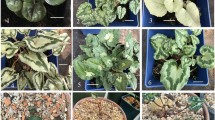Abstract
With the goal of developing an accurate plant identification method, molecular analysis based on polymorphisms of the nucleotide sequence of chloroplast DNA (cpDNA) was performed in order to distinguish four Curcuma species: C. longa, C. aromatica, C. zedoaria, and C. xanthorrhiza. Nineteen regions of cpDNA were amplified successfully via polymerase chain reaction (PCR) using total DNA of all Curcuma plants. Using the intergenic spacer between trnS and trnfM (trnSfM), all four Curcuma plant species were correctly identified. In addition, the number of AT repeats in the trnSfM region was predictive of the curcumin content in the rhizome of C. longa.

Similar content being viewed by others
References
Wu D, Larsen K (2000) Curcuma Linnaeus. In: Wu ZY, Raven PH (eds) Flora of China. Science Press, Beijing, p 359
Sasaki Y, Fushimi H, Cao H, Cai SQ, Komatsu K (2002) Sequence analysis of Chinese and Japanese curcuma drugs on the 18S rRNA gene and trnK gene and the application of amplification-refractory mutation system analysis for their authentication. Biol Pharm Bull 25(12):1593–1599
Kitamura C, Nagoe T, Prana MS, Agusta A, Ohashi K, Shibuya H (2007) Comparison of Crucuma sp. in Yakushima with C. aeruginosa and C. zedoaria in Java by trnK gene sequence, RAPD pattern and essential oil component. J Nat Med 61:239–243
Taberlet P, Gielly L, Pautou G, Bouvet J (1991) Universal primers for amplification of non-coding regions of chloroplast DNA. Plant Mol Biol 17:1105–1109
Nishizawa T, Watano Y (2000) Primer pairs suitable for PCR-SSCP analysis of chloroplast DNA in angiosperms. J Phytogeogr Taxon 48:63–66
Demesure B, Sodzi N, Petit RJ (1995) A set of universal primers for amplification of polymorphic non-coding regions of mitochondrial and chloroplast DNA in plants. Mol Ecol 4:129–131
Tsumura Y, Kawahara T, Wickneswari R (1996) Molecular phylogeny of Dipterocarpaceae in Southeast Asia using RFLP of PCR-amplified chloroplast genes. Theor Appl Genet 93:22–29
Hasebe M, Ito M, Kofuji R, Ueda K, Iwatsuki K (1993) Phylogenetic relationship of deduced from rbcL gene sequence. J Mol Evol 37:476–482
Watanabe T, Mazumder TK, Yamamoto A, Nagai S, Terabe (2000) Separation and determination of curcuminoids in turmeric samples by miceller electrokinetic chromatography with a high molecular mass surfactant. Nippon Shokuhin kagaku kaishi 47:780–786
Govindarajan VS (1980) Turmeric-chemistry, technology and quality. CRC Crit Rev Food Sci Nutr 12:199–301
Rakhunde SD, Munjal SV, Patil SR (1998) Curcumin and essential oil contents of some commonly growth turmeric (Curcuma longa L.) cultivars in Maharashtra. J Food Sci Technol 35:352–354
Mikage M, Yoshimitsu M, Matsui A, Kawahara K, Kakiuchi N (2003) Evalution of the crude drugs by means of colorimeter. Part5. Correlation between the color and curcumin content of turmeric. Nat Med 57:246–249
Acknowledgements
This study was supported by the research fund of the Japan Kampo Medicine Manufacturers Association and a grant from the High-Tech Research Center Establishment Project of the Ministry of Education, Culture, Sports, Science and Technology.
Author information
Authors and Affiliations
Corresponding author
Rights and permissions
About this article
Cite this article
Minami, M., Nishio, K., Ajioka, Y. et al. Identification of Curcuma plants and curcumin content level by DNA polymorphisms in the trnS-trnfM intergenic spacer in chloroplast DNA. J Nat Med 63, 75–79 (2009). https://doi.org/10.1007/s11418-008-0283-7
Received:
Accepted:
Published:
Issue Date:
DOI: https://doi.org/10.1007/s11418-008-0283-7




